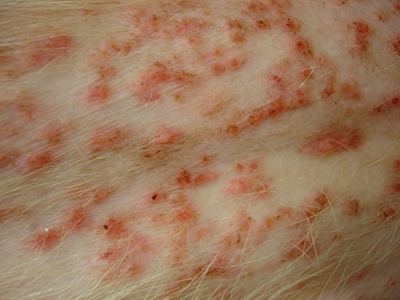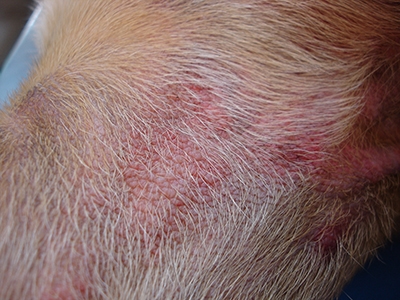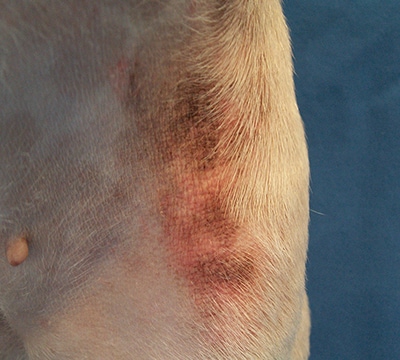Shampoos for dogs and cats
The maintenance of the skin and coat of our domestic carnivores, as well as the treatment of dermatoses (skin diseases), always involves the use of topicals, that is to say, medications or cosmetic products acting locally.
Author: J.L. Mathet – September 2016
Definitions
The skin is a complex organ, the most extensive of the body, which constitutes a fundamental anatomical and physiological barrier, the cutaneous barrier, between the external environment and the internal environment. The skin reflects the physiological state of the entire organism and helps maintain its biochemical and thermal homeostasis (that is, equilibrium).
It is difficult to define ‘healthy’ skin because, as E.BENSIGNOR and E.VIDEMONT explain in their Practical Guide to Veterinary Dermocosmetics, every dog or cat has skin and a coat that are specific to them. The notion of cutaneous normality is based on aesthetic, physiological and functional criteria specific to the individual (age, breed, sex, heredity). Furthermore, external parameters also influence skin health (environment, diet, living conditions).
This contact surface is therefore suited to local treatments, whether shampoos, sprays, creams, ointments, wipes, foams, spot-ons (pipettes for application), gels, lotions, and more. Shampoos are liquid products composed of cleansing surfactants combined with thickeners, softeners, moisturizers, and fragrances. Their purpose is to clean without damage, by removing dirt, restoring the cutaneous ecosystem, and combating odours.
Some formulations have complementary activities and contribute to the treatment of dermatoses with their soothing, anti-seborrheic, desquamation-regulating, or antiseptic actions. Finally, there are shampoos considered full-fledged medications and thus are dispensed by prescription.
Surfactants are molecules with an affinity for water and oil (called amphiphilic), with a hydrophilic head that attracts water and a lipophilic tail that attracts oil. Their surfactant properties allow them to mix water and oil and are stable over time. These agents therefore have the capacity to adsorb on various interfaces (water/oil, air/water) and reduce surface tension (wetting), to form emulsions, then to solubilise and disperse debris during rinsing.
Shampoos suitable for dogs (and cats) should therefore have high cleansing and foaming effects, a pleasant texture and scent to use, and be easy to rinse. Furthermore, excellent physiological tolerance is essential, taking into account the physiological peculiarities of their skin and especially the pH, which is considered to be rather neutral to basic (from 7.4 to 8.5) unlike humans whose skin has a more acidic pH.
Washing
Several effects are sought after when shampooing:
a mechanical action by removing dirt, excess scales, and crusts, thanks to the combined action of water and cleansing agents
a therapeutic action associated with the present dermatosis (anti-seborrheic, antiseptic, moisturizing, soothing, restructuring effect)
a cosmetic action by improving the visual aspect of the coat, its shine, its suppleness
These actions will be effective if a few simple rules are followed:
- perform a preliminary brushing of the coat to remove major debris and dead hair
- take your time ! a hasty shampoo, done quickly, cannot be effective, the animal and its owner will be stressed and compliance will be poor
- prepare your equipment (brushes, products, towels)
- perform the baths in a room suited to your pet (size, nervousness, receptivity), and provide an anti-slip mat to limit slipping
- use lukewarm to moderately hot water
- use a sufficient amount of product and massage the coat thoroughly, focusing on areas that need treatment (a general shampooing is irrelevant for localized dermatoses)
- start from the front of the animal and finish at the back, top then underneath, avoiding the mucous membranes, eyes, and ingestion of product
- allow the active ingredients to work for 5 to 10 minutes before rinsing, and gently stroke the animal to keep it calm
- rinse thoroughly, making sure not to forget any areas exposed to the shampoo
- ideally 2 shampoos should be performed : the first quite fast for a washing effect, the second prolonged for the desired treating or preventive effect, with extended contact time
- dry with absorbent towels in the direction of the hair, and possibly with a hairdryer while brushing the coat
Different products with different active ingredients can also be used successively with careful rinsing in between, to combine their effects, for example, an antiseptic shampoo followed by an emollient or moisturizing shampoo. Lotions can also be applied on the still damp coat to enhance the moisturizing or beautifying effect.
The frequency of shampoos should be adapted depending on what is expected from their action, the animal’s environment, its health, its coat, and the owner’s wishes. For simple coat maintenance, washes can be done throughout the year at regular intervals.
When a therapeutic action in managing a dermatosis is sought, shampoos may initially be biweekly or even daily, then spaced two or three times a month according to the clinical response. Of course, the availability and consent of the owner must be taken into account: some treatment shampoos can effectively be performed at the clinic.
The storage of shampoos should also be considered: indeed, poorly cleaned caps or necks, or poorly stored bottles can be colonized by pathogenic bacteria and subsequently spread on the coat during future shampoos. Cases of skin infections have been described following the use of contaminated shampoos.
Active ingredients and usage modalities of shampoos
Various active agents can be distinguished according to the desired objective and any dermatosis involved.
For maintaining ‘healthy’ skin, regular use shampoos should be used, where foaming and washing power, and high tolerance will be sought. These are gentle, washing, moisturizing products that ensure a shiny coat.
Skin infections (or pyodermas)
Pyodermas are microbial skin infections caused by bacteria and pus production. Many species of bacteria are present on healthy skin and balance each other to avoid abnormal proliferation. Skin is an effective barrier against external aggressions and thus prevents the occurrence of infectious diseases. During imbalances due to external or internal factors, germs ordinarily unable to multiply will proliferate and lead to a purulent infection (photo 1).

Antiseptic shampoos play an important role here in conjunction with the use of antibiotics. They even reduce the usage, through their adjuvant action, which is currently a recommended direction with the increase of antibiotic resistance.
The main active ingredients are chlorhexidine, povidone-iodine, benzoyl peroxide, ethyl lactate, or piroctone olamine. There are also molecules with sanitizing action, but unable to claim a real antiseptic action, as in phytotherapy or more recently silver combined with hyaluronic acid.
Allergic dermatitis
In addition to the mechanical action related to washing which allows the removal of surface allergens, effective rehydration and emollient and soothing effects are sought in shampoos intended to relieve inflammatory skin from allergic conditions (photos 2 and 3).

The active principles also used are essential fatty acids, monosaccharides, epidermal lipids (phytosphingosine), colloidal oat extracts, essential oils from phytotherapy, local corticosteroids.

There are many presentations available, their regular application having a brief anti-pruritic action, but complementing oral anti-inflammatory treatments (antihistamines, corticosteroids, cyclosporine). This sparing effect is particularly sought after during the use of oral corticosteroids, which are deleterious in the long-term for the animal.
Kerato-seborrheic conditions
Here we distinguish between dry seborrheas, oily seborrheas, skin thickening (hyperkeratosis), scaly dermatoses, acne, and comedone-prone skin. Depending on the presentation, the coat will be dull or oily-looking, sometimes streaked. Keratinization abnormalities produce large amounts of scales (“dandruff”), of varied sizes and appearances. We distinguish between primary disorders (metabolic or genetic), and secondary disorders due to other dermatoses (parasitic, allergic, dysendocriness…) (photo 4).

The sebaceous glands, sweat glands, and keratinocytes produce a protective lipid layer that covers the skin in mammals. This lipid film is made up of glandular sebum and the inter-corneocyte film. It contains triglycerides, ester waxes, cholesterol, ceramides, and free fatty acids. Any disturbance in this composition also leads to seborrheic disorders.
The aesthetic and cosmetic harm of these dermatoses is significant as it alters the external appearance of the animal. The odours produced in oily seborrhea are sometimes unpleasant and persistent (rancid lipid smell).
Additionally, bacterial (staphylococci) and fungal (Malassezia yeast) infectious complications are common and require specific management where local care and especially antiseptic shampoos are very important.
The active principles used are so-called keratomodulating agents, meaning they regulate the excessive proliferation of horny cells (keratoplastic) or allow the removal of excess scales and horny plaques (keratolytic). Anti-seborrheic agents reduce sebaceous production, and emollients allow for better skin hydration by increasing the water content in the epidermis.
| Keratomodulating agents | Anti-seborrheic agents |
| Salicylic acid | Benzoyl peroxide |
| Coal tar | Selenium disulfide |
| Sulphur | Zinc gluconate |
| Ammonium lactate | Vitamin B6 |
| Phytosphingosine | Phytosphingosine |
| Selenium disulfide | Essential fatty acids |
| Essential oils (phytotherapy) | |
| Lipidic emollients | Non-lipidic emollients |
| Vegetable oils (olive, sesame, coconut) | Glycerine |
| Animal oils (lanolin) | Lactic acid |
| Mineral oils (paraffin, vaseline) | Fatty acid polyesters |
| Propylene glycol | |
| Urea | |
| Chitosanide |
Conclusion
The composition in active principles is fundamental when used for topical management of dermatoses. There are very many ranges available, and each one will be chosen according to the indications, the appearance of the product, and its ease of use (foaming effect, fragrance, ease of rinsing). Veterinary dermatological range products will logically be preferred when a therapeutic effect is expected: your veterinarian can advise you. Of course, other topical alternatives exist (sprays, foams, wipes, gels, ointments) to be used according to the areas to treat, the coat, and the convenience of use.
In any case, shampooing your pet is a rewarding, useful, and effective act if the right product is used and one is organized. Better to have a lower frequency but a shampoo properly applied and rinsed than a hasty bath, in the stress of the owner… and their pet!